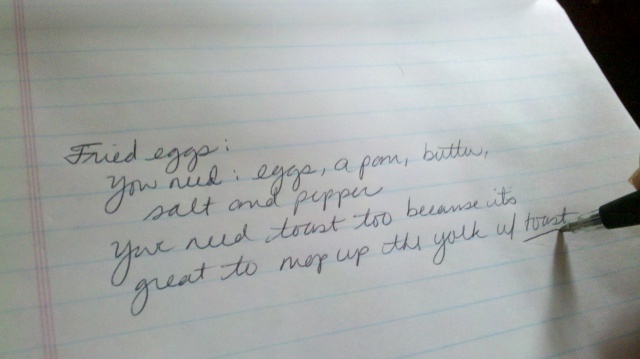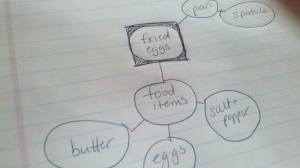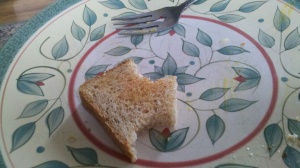Let’s get one thing straight: I am not the Bibliography Queen.
I do not derive pleasure from looking at a list of 34 sources, scrutinizing them for the finer points of alphabetization (numbers before letters, and don’t forget to skip “The” as a first word – “The Silver Chair” should go under S …), or policing punctuation (a period after the “d” as in ed. for editor, but not after the “t” in et al., which is done only when there are more than two authors, and incidentally, the first author is listed last name, first name, but the second author is listed first name (no comma) last name). I don’t have all of these formatting conventions memorized in my head, nor are they as straightforward as they might seem (in fact, I imagine there might be a little heated discussion among some educators about the “more than two authors” thing).
And yet, I still request to see the bibliographies (now called “works cited” pages) from every teacher who does a research unit in our school. And here are some reasons why you might want to require one in your next project.
Bibliographic Conventions
Bibliographic conventions are the rules that help keep citations standard across disciplines. Very often, students are surprised when I tell them that they will continue using the same method of citation in upper school, and at least something similar beyond. They seem to think works cited pages are a form of torture designed to frustrate students and waste their time. After all, the Internet doesn’t cite their sources, why should they? (Incidentally, I recently pulled this point of information on a class of 8th graders – Wikipedia will now flag your entry as being of questionable authority if you do not cite your sources. Ha.)
Let’s go back to how and why we taught bibliographic conventions prior to the “information explosion” that was facilitated by the introduction of the Internet into general usage. Some of those reasons still exist today: we want to encourage the responsible and ethical use of information and ideas; we want to help interested readers find our sources again; we want to teach a format which is accepted in the world of academia, and; we want to encourage students to back up their writing with authoritative information.
Some of the skills we used to teach have been made less vital through technology. For example, there are tools to help us with these conventions. NoodleTools, Citation Machine, and any number of electronic bibliographic formatters can do the job of putting citation information into the correct format. When NoodleTools first came out, I remember thinking in a “librarian-up-on-the-bibliographic-soapbox” kind of way: “but they will still need to learn how to do a bibliography!” And I thought, well, let me teach them how to do a bibliography, and then I’ll let them do the “cheater” version after I’m satisfied with their capacity to do it on their own.
I have since learned to see this attitude as “digital immigrant*” thinking, and I have to be vigilant for it. It occurred to me during the course of the next few years that students are never going to have to do this on their own. Technology that helps us to manage information is here to stay, even to the point where there is now a number of services (Zotero is one of them) that will cite your web page for you from the page itself. People are beginning to tag their webpages with HTML that interfaces with these programs and fills in the form for you. This kind of technology makes even NoodleTools start looking a little archaic.
And the truth is, there’s always been help for bibliographic formatting. Ever since the MLA, APA, Turabian and Chicago Style manuals created a standardization for citation, there have been “cheat sheets” and books describing how to cite every type of source – and as the kinds of sources we are using expands, those rules need to be revised again and again.
There are still things to learn, good things, that cannot be helped by using electronic citation assistance. NoodleTools can, sometimes, suggest that a word be capitalized, or that certain words or phrases be truncated. (For example, NoodleTools will tell you that it’s unnecessary to put “Thompson Gale Publishers” – it can simply be “Thompson Gale”). But it cannot tell you that Mississippi is spelled “M-i-s-s-i-s-s-i-p-p-i” and not “M-s-i-s-s-s-p-p-p-I,” and it cannot tell you that Google is not a source, but rather, a tool used to find sources. And it cannot tell you that the webpage your 7th grader just cited for her report was actually written by Mrs. Preston’s Third Grade Class. (No offense to Mrs. Preston or her hard-working Third Graders).
But this is still not the primary reason for requiring – and examining – a works cited page.
Information Literacy
Students today need to do the same things that we had to when it comes to research, but they are doing it in an completely different environment. We want them to evaluate and choose quality sources, to know where those sources are coming from, to search them successfully, and to read and understand them. The works cited page, even without access to the project itself, helps me to see how well students are achieving these objectives, and what further practice and instruction they might need.
What types of sources are students using?
How do students define a “credible source?” If you ask a group of students how the results are ranked in a Google search, some might say that they pay to be up front, but more will say that the best information is listed first. This belief has a few frustrating consequences. If the search engine can somehow read your mind and put the best information first, then if there’s nothing that helps you on that first page of results, then it follows logically that “There’s nothing about “light” on the Internet.”
How well are students following the requirements of the assignment? If a newspaper article is required, did they use a blog posting and call it a newspaper article because the blog contained the word “article” in it?
NoodleTools will make you decide what type of source you are citing before you cite it. For example, this citation:
Case, Joy. “Golden GateBridge.” Kids Search. 23 Sept. 2008.
<http://web.ebscohost.com>.
This student did a good job – she used a reliable source from an EBSCO database, and she discovered the author. By going to the database and recreating her search process, I can see that she began with a quick keyword search for “Golden GateBridge” and received too many unrelated results. Then she noticed the subject heading bar on the results page and discovered that this database calls her topic: “Golden GateBridge(San Francisco,Calif.).” She then used this to find her article, which was the first at the top of the results page. Many students her age would have given up when they looked at the first result page with the unrelated articles. So I know that she can use some of the search conventions of a database, which is a skill very different from using a search engine. The database is indexed – but the Internet is not (yet).
Now, I can also see that this student knew she was citing a reference source, rather than a webpage, because her format tells me she used the Subscription Database “wizard” feature, which helped her by shortening the URL to the homepage instead of copying and pasting the entire URL from the address bar. There was one problem, though. She lists her source as “Kids Search” (the name of the database search feature: i.e., Kids Search is to EBSCO Databases as Google is to Internet). The name of the journal the article is from is “Our States: Geographic Treasures.” This title was listed with the bibliographic information, and at the bottom of the page under the heading “Source.” But the big “Kids Search” at the top of the page made her believe that was the source title, just as a webpage would list its title at the top of the page. So, this student still needs some work on identifying what kinds of sources are found in a database.
Pretty good information from one simple line in a bibliography, huh?
Where do students believe their sources originate?
Imagine that you’ve grown up in a world where your school library has only one book. That book is not indexed alphabetically and the page numbers aren’t sequential. The book has 3 million authors and there is no guarantee that the information you found in it today will be the same when you look in it tomorrow.
The above illustrates how many of our students see the information landscape. Most of their information “comes from” a computer screen. A webpage, a database, an ebook, a newspaper article – it all appears in the same place, and therefore, seems to come from the same place. If it’s on the screen, it must be a webpage.
When I ask students to brainstorm places they might find information, the first thing they often say is “The Internet” or (gasp!) “Google.” They I say “which source on the Internet?” and eventually we may get to the name of a specific place. Here’s an example of a bibliographic citation I have seen from a student:
http://www.stpetersburger.com/oview_img/matryoshkas-dolls.jpg. Google. Google. November 24, 2008. http://images.google.com/imgres?imgurl=http://www.stpetersburger.com/oview_img/matryoshkas-dolls.jpg&imgrefurl=http://www.stpetersburger.com/html/matryoshkas.html&usg=___h6756Q0i4VmLhfCnkVYoMMdS_Y=&h=304&w=305&sz=50&hl=en&start=2&sig2=cIc3LAYxtxH8C9TL3_FU_g&tbnid=82w78vo94EPT4M:&tbnh=116&tbnw=116&ei=41ssSbG0EaSIeaLsuM8E&prev=/images%3Fq%3Dnesting%2Bdolls%26gbv%3D2%26hl%3Den
Here is what this citation tells me: The title of the photo is its web address. The webpage the photo came from is Google. The sponsoring organization is Google. You can find it at Google.
I recently presented at a teacher training where the teachers were learning to insert images into their course “Moodle” pages . We decided that for an example picture, we would find a picture on the internet of some “Baltimore Honies.” One teacher said “Go to ‘Café Hon’ – they’ll probably have some pictures. Another suggested a different website. Where would a students have looked first? Google Images. This is an unexpected and powerful illustration of how an information literate person uses the Internet, compared with someone who is just learning – the literate person will use a search engine to find a source – the student of information literacy will use a search engine to find the “answer” itself.
So what? Both groups of people get the job done, right?
Another recent example from my own research and public speaking class may help to shed some light on this problem. The students had chosen speeches, poetry and readings to practice. We were talking about what to include in an introduction to “The King’s Breakfast” by A.A. Milne, that would help prepare the listener for the reading. One of the suggestions was “a summary of the poem.” When I asked what source we might use to come up with that summary, I was proud to hear “the poem itself” (with a faint tinge of “duh!”) from one of my students. I have seen students say “Go to Google and type in ‘summary of the kings breakfast.’” When students begin to think that finding a summary on the Internet is preferable to, or more logical than, using their own abilities of summarization,that is a real information literacy dilemma.
How successful are students at searching electronic sources?
A works cited page is also a breadcrumb trail for looking at how students are searching for information. For example, if there are five sources listed and they are all websites, I head to “Google” and type in a likely search phrase. If those five websites are listed on the first page of results, I know we have a problem. Most students will stop at the first source they believe meets the requirement of our information. This is a pretty natural thing to do, if you think about it. When you look up a word in the dictionary, you don’t usually check it with three other dictionaries to make sure it is correct. But for the kind of searching we want them to do – to find appropriate materials, at their reading level and from trusted sources. The difference between these two is what I call Hunter/Gatherer searching. They both result in a steady diet of information, but each must be used for the appropriate task. If I’m looking for facts or the answer to a straightforward question like: “What is the chemical symbol for Gold?,” I go to the quickest reference available (online or print). I hunt down the answer – I’ve got it – good – I’m done. But the Gathering search seeks to draw information from a variety of points of view, formats, and origins. I need to absorb and interpret that information to answer a complex problem like: “Write a newspaper article from the point of view of someone witnessing the Great Baltimore Fire of 1904” That’s a tough one to find on a search engine, and a tough assignment to plagiarize, I might add. (I just tried Googling it now, and my favorite result is from “The Cthulhoid Chronicle” – any Lovecraft fans out there?). Students need to see that searching takes work – reading and evaluating – and that the answers will not always be handed to them in a perfect package.
If the assignment requires a database source, and I see only webpages cited, I start to ask questions about how successful the student is at searching databases. I want to see how the student is searching and if she is becoming frustrated by the database search features. Very often, changing the type of search from “Subject” to “Keyword” will solve the problem.
If a student cites a search result page, and not the actual article, I wonder if he is clicking on the article and reading it. I wonder if he thinks that the 3 line summary of the article is the article itself. Students expect their information to come in small, digestible packages. They routinely reject a source because there’s “too much reading.” If it’s not quick and easy, then they move on to the next thing until they find it, or ultimately decide that the information does not exist.
How well are students reading and understanding their sources?
Let’s step into the “Research Wayback Machine” to when I was a 7th grader. I had to do a project onKenya. It was required that we use at least 5 sources. If you used less than 5 sources, you were marked down. If you used more than 5 sources, you were praised as a “self-starter,” and maybe even an “enlightened” student. Your searching skills were obviously first-rate, because information was scarce. If you used 5 you were ok, but maybe look a little harder next time, huh? You don’t just want to do the minimum, now, you want to reach higher …
By praising students for the increasing number of sources they “found,” we unwittingly set the course for a collision with the increased popularity of the Internet. Now, suddenly, students could find 3,456,596 “sources” on a topic. Now, the same paper onKenyawhich the enterprising young student found 6 sources for, is now presenting a paper with 34+ sources.
Red flag.
I didn’t have this problem growing up, because we weren’t experiencing an information explosion at the time. I was lucky if I could squeeze out 7 sources between the school library, the public library, and videotaping NOVA. Now, students have access to multiple sources and formats of information. And most of that information has no editorial control.
And so, we not only have a minimum requirement for sources, but a maximum as well. As an instructional designer, you figure out the amount of sources a student will need to do the project well, add a few more sources, and then cap it. So now students receive the instruction: “You need at least 4 sources, but no more than 7.” When you have to decide which sources you will use for a project, you need to look beyond the title of the page. If you have only 6 sources to use, you are not going to pick the one that has one line about your topic – you are going to look at the source and make sure that it fulfills your assignment. (Or you’re going to lie and say you only used 6 sources when in fact you used 10, but then you have a different problem on your hands).
Just Another Piece of the Puzzle
I use the information I glean from the works cited page to assess the student progress in research, and to see where I need to go next. It might be a discussion about Wikipedia and the nature of wikis and collaborative sources in general. It might be a lesson on the difference between an index, a search engine, and a database. But I will tailor it based on what I can see they need to know. And it keeps me in their world – how they are searching, what they are coming up with in the world …
All of this useful information from looking at a citation! Think of what could be done if you had the final product on hand to add to your understanding!
Try not to see the “dreaded bibliography” as a relic of the days of picayune editing and card catalogs. If you want to really try to help students maneuver today’s information landscape, consider requiring a works cited page. And then when you examine it, look beyond the commas and the spelling and the quotation marks to what the student is really telling you about how they see the information world.
*See Marc Prensky









